An (Ten Year) Overnight Success
As a startup company, it can be difficult to pause and celebrate the wins along the way. This week, we’re taking a moment to acknowledge the team effort that has resulted in AtScale being recognized as the Leader in GigaOm’s Semantic Layers and Metrics Stores Sonar Report – a new report which provides a comprehensive overview of vendors in the semantic layer and metrics store domain. While we take stock of the enormous progress we’ve made as a company and technology, we’re focused on the exciting product developments that will soon be announced to help our customers realize their data and analytics goals.
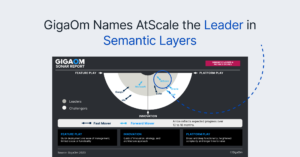
Semantic Layers: Evolving to Meet Modern Data Expectations
A semantic layer is not new to the enterprise analytics stack. There have been many incarnations of technologies to help analytics teams bridge the gap between raw data and actionable insights. With the advent of the modern data stack and the shift of data gravity from on-premise to the cloud, the needs of the enterprise customer to deliver consistent data definition at cloud scale has become an incredibly complex problem to solve.
GigaOm’s recognition of AtScale as the leader for Semantic Layers and Metrics Stores and our 10 years of experience helping the largest organizations drive economic outcomes from their analytics is a testament to the value of AtScale’s semantic layer in the modern data stack.
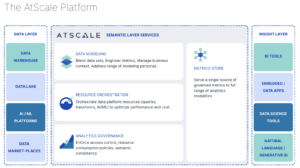
What Sets AtScale Apart
GigaOm highlighted several areas where AtScale excels (pun intended), including:
OLAP Interface to Cloud Data:
As GigaOm points out in their report, “The return to semantic layers and metrics stores represents at least a conceptual return to the OLAP methodology, even if not a return to OLAP technology. In hindsight, this shows that what the industry really needed was a technology change, not a methodology change, even if it seemed it couldn’t have one without the other.”
Customers turn to AtScale to leverage the best of OLAP’s methodology while blending it with a modern technology approach. Our semantic layer allows our customers to take advantage of the structural optimizations of OLAP and the elasticity and scalability of modern cloud data platforms.
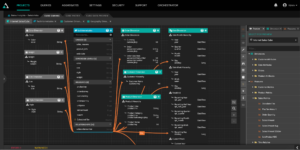
Client Side Connectivity
Enterprise organizations have invested tens of millions of dollars and countless hours implementing and supporting a wide range of BI/analytics tools like Microsoft Excel, Power BI, Tableau, Looker, Qlik, Microstrategy and more. While nearly every organization is on a path to modernize their data to the cloud, there isn’t the same eagerness within the business to change how the data is analyzed. AtScale provides native dialect integrations of MDX (Excel), DAX (Power BI), Python (AI/ML), REST (Custom Development) and SQL (Tableau, Looker) to enable business stakeholders to continue using the BI/analytics tools they love without compromise, while taking advantage of the scale of modern cloud platforms.
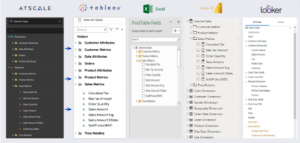
Multi-Persona Approach
Large organizations have both technical and non-technical subject matter experts who are responsible for semantic modeling. AtScale offers a no-code, drag and drop interface for BI modelers and business analysts. Analytics engineers and data scientists have the ability to leverage AtScaleML (currently in preview), a code-first modeling language and/or AI-Link, a Python interface to AtScale’s semantic layer. All modeler personas are able to access our object library which enables them to share and reuse model assets, accelerating the creation of new semantic models while enabling consistent, decentralized data model development.
Query Acceleration
One of the benefits of OLAP is query performance. Business users are used to doing ad-hoc analysis with sub-second response times. AtScale’s autonomous data engineering automatically creates, updates, appends and prunes aggregate tables to give end users the query performance they’re used to without the need to pre-compute any data or build cubes. All of these aggregate tables reside in cloud data platforms like Databricks, Snowflake, Google BigQuery, AWS Redshift, InterSystems IRIS and Azure Synapse, enabling analysts to take advantage of cloud elasticity and scale while eliminating the need to make additional copies of data.
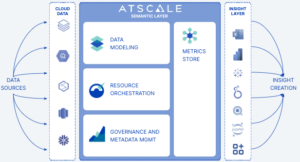
Security and Authentication
When working with large enterprises there is a wide range of security and authentication requirements. AtScale integrates with a wide range of authentication and identity management solutions like Azure AD, LDAP, Okta, OAuth and more. In addition to user authentication, AtScale provides role-based access controls for managing data access including: r column filtering, masking and row level security.
Get up to speed on Semantic Layers
GigaOm’s Sonar Report offers an incredibly thoughtful analysis of semantic layers and their importance in the modern data stack. There are so many considerations to make when trying to identify the right technology to solve an analytics problem. We believe that AtScale is the best semantic layer on the market but you don’t have to take our word for it, read the report to learn for yourself.
Click here to get your version of GigaOm’s Sonar report for free.


SHARE
Case Study: Vodafone Portugal Modernizes Data Analytics